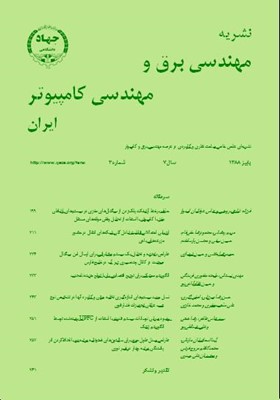بهبود ميرایي نوسانات سيستم قدرت با استفاده از UPFC بهينهشده توسط الگوريتم ژنتيک
محورهای موضوعی : مهندسی برق و کامپیوترسيدعباس طاهر 1 * , رضا همتي 2 , علي عبدالعليپور 3
1 - دانشگاه كاشان
2 - دانشگاه كاشان
3 - دانشگاه كاشان
کلید واژه: ادوات FACTS UPFCالگوريتم ژنتيکميرایي نوسانات سيستم قدرت,
چکیده مقاله :
در اين مقاله به طراحي کنترلکننده ميراساز براي ميرایي نوسانات سيستم قدرت بر مبناي UPFC پرداخته شده است. سيستم تحت مطالعه يک سيستم تکماشينه متصل به شين بينهايت ميباشد. ابتدا مدل خطي بهفرم فضاي حالت براي سيستم تکماشينه متصل به شين بينهايت آورده شده و سپس کنترلکننده مذکور با روش بهينهسازي الگوريتم ژنتيک براي اين سيستم بهينهسازي شده است. تأثير کنترلکننده ميراساز بر ميرایي نوسانات سيستم قدرت از طريق شبيهسازي غير خطي در حوزه زمان نشان داده شده است. همچنين براي نمايش ويژگيهاي کنترلکننده طراحيشده نتايج اين کنترلکننده با يک کنترلکننده کلاسيک مقايسه شده که نتايج برتري کنترلکننده طراحيشده را نسبت به کنترلکننده کلاسيک نشان ميدهد.
In this paper, the use of the supplementary controller of a Unified Power Flow Controller (UPFC) to improve damping of oscillations in Single Machine Infinite Bus (SMIB) system is investigated. The controller was designed based on a linearized modified Phillips Heffron model of SMIB in state space form. In practice systems use simple Proportional Integral (PI) controllers to control UPFC. However, since the PI control parameters are usually tuned based on classical or trial-and-error approaches, they are incapable of obtaining a good dynamic performance for a wide range of operation conditions. To address this problem, in this research an optimization approach, based on the Genetic Algorithms (GA) method is proposed for the design of UPFC controller (supplementary damping controller) for increasing damping of power system oscillations is developed. Several linear and nonlinear time-domain simulation tests clearly show the effectiveness and validity of the proposed method in enhancing of oscillations257-260damping. Comparisons between the performances of both the proposed and conventional supplementary controllers are made. Computer test results show that proposed method is very effective in oscillations damping and in the meantime is more robust than its conventional counterpart.
[1] C. L. Chen and Y. Y. Hsu, "Coordinate synthesis of multi-machine power system stabilizer using and efficient decentralized model control (DMC) algorithm," IEEE Trans. on Power System, vol. 9, no. 3, pp. 543-551, Aug. 1987.
[2] M. J. Gibbard, "Co-ordinate design of multimachine power system stabilizer based on damping torque concepts," in IEE Proc. Pt. C, vol. 135, no. 4, pp. 276-284, May 1988.
[3] M. Klein, L. X. Le, G. J. Rogres, S. Farrokhpay, and N. J. Balu, "Damping control design in large power system," IEEE Trans. on Power System, vol. 10, no. 1, pp. 158-166, Feb. 1995.
[4] V. G. D. C. Samarasinghe and N. C. Pahalawaththa, "Damping of multimodal oscillation in power system using variable structure control techniques," IEE Proc. Gen. Trans. and Distrib., vol. 144, no. 3, pp. 323-331, May 1997.
[5] A. A. Eldamaty, S. O. Faried, and S. Aboreshaid, "Damping power system oscillation using a fuzzy logic based unified power flow controller," in Proc. IEEE Canadian Conf. on Electrical and Computer Engineering, CCECE/CCGEI 2005, pp. 1950-1953, May 2005.
[6] A. R. Mahran, B. W. Hogg, and M. L. El - Sayed, "Coordinate control of synchronous generator excitation and static var compensator," IEEE Trans. Energy Conversion, vol. 7, no. 4, pp. 615-622, Dec. 1992.
[7] N. G. Hingorani and L. Gyugyi, Understanding FACTS, IEEE Press, New York, 2000.
[8] L. Gyugyi and C. D. Schauder, "The unified power flow controller: a new approach to power transmission control," IEEE Trans. on Power Delivery, vol. 10, no. 2, pp. 1085-1093, Apr. 1995.
[9] L. Gyugyi, "Unified power flow control concept for flexible AC transmission systems," IEE Proc. - C, vol. 139, no. 4, pp. 323-331, Jul. 1992.
[10] K. Sedraui, G. Oliver, K. Al - Haddad, and A. Chandra, "Versatile control strategy of the unified power flow controller," in IEEE Canadian Conf. on Electrical and Computer Engineering, CCECE 2000, pp. 142-147, May 2000.
[11] A. Nabavi Niaki and M. R. Irvani, "Steady-state and dynamic models of unified power flow controller (UPFC) for power system studies," IEEE Trans. Power Sys., vol. 11, no. 4, pp. 1937-1943, Nov. 1996.
[12] K. S. Smith, L. RAN, and J. Penman, "Dynamic modeling of a unified power flow controller," in IEE Proc. - C Gen. Trans. Dist., vol. 144, no. 1, pp. 7-12, Jan. 1997.
[13] H. F. Wang, "A unified model for the analysis of FACTS devices in damping power system oscillation part III: unified power flow controller," IEEE Trans. Power Delivery, vol. 15, no. 3, pp. 978-983, Jul. 2000.
[14] N. Tambey and M. L. Kothari, "Damping of power system oscillation with unified power flow controller (UPFC)," in IEE Proc. - C Gen. Trans. Dist., vol. 150, no. 2, pp. 129-140, Mar. 2003.
[15] N. Li, Y. Xu, and H. Chen, "FACTS - based power flow control in inter connected power systems," IEEE Trans. Power Syst., vol. 15, no. 1, pp. 257-262, Feb. 2000.
[16] E. Gholipour and S. Saadat, "Improving of transient stability of power systems using UPFC," IEEE Trans. Power Delivery, vol. 20, no. 2, pp. 1677-1682, Feb. 2005.
[17] L. H. Randy and E. H. Sue, Practical Genetic Algorithms, Second Edition, 2004.
[18] Y. N. Yu, Electric Power System Dynamics, Academic Press, Inc London, 1983.
[19] H. F. Wang, M. Li, and F. J. Swift, "FACTS - based stabilizer designed by phase compensation method, part I and II," in Proc. of APSCOM ' 97, pp. 638-649, Hong - Kong, 1997.

